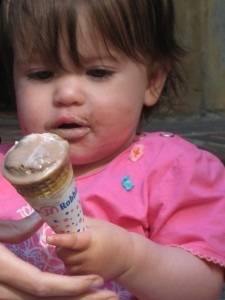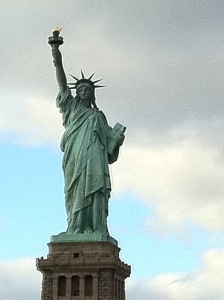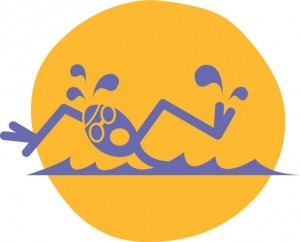 Oh that first taste of the stuff called ice cream — especially when it comes in its own hand held package!
Oh that first taste of the stuff called ice cream — especially when it comes in its own hand held package!
Food for Fun and Thought
Need To Work Off Some Extra Calories?
According to Health Day TV there are some great outdoor ways to burn off a few of those extra calories you consumed – perhaps the ones left over from an indulgent 4th of July barbecue.
For each hour of activity (caloric burn varies somewhat with your size and effort):
- Golf, walking with your clubs: 330 calories
- Leisurely bicycling under 10 miles per hour: 290 calories
- Bicycling over 10 miles per hour: 590 calories
- Leisurely walking: 280 calories
- Jogging at a 12 minute per mile pace: 590 calories
- Swimming slow freestyle laps: 510 calories
- Hiking: 370 calories
- Yard work: 330 calories
Happy 125th Birthday Statue of Liberty!
 125 years ago the Statue of Liberty was given to the people of the United States by the people of France in recognition of the friendship they formed during the American Revolution. The Statue of Liberty’s symbolism represents freedom and democracy along with international friendship.
125 years ago the Statue of Liberty was given to the people of the United States by the people of France in recognition of the friendship they formed during the American Revolution. The Statue of Liberty’s symbolism represents freedom and democracy along with international friendship.
The Statue was a joint effort between America and France. Americans built the pedestal and the French people were responsible for the Statue’s design and manufacture and for its assembly in the United States.
Happy 125th Birthday Lady Liberty and Happy 235th Birthday America
Have Some Oil With Your Cereal And Toothpaste
 Sunday’s New York Times had a great piece on how “oil oozes through your life.” The article points out that whale oil used to be the go to energy source in the 18th and 19th centuries, but more than a century ago petroleum became the major source of fuel. Oil is abundant and with some laboratory effort it can be turned into more things than you can imagine.
Sunday’s New York Times had a great piece on how “oil oozes through your life.” The article points out that whale oil used to be the go to energy source in the 18th and 19th centuries, but more than a century ago petroleum became the major source of fuel. Oil is abundant and with some laboratory effort it can be turned into more things than you can imagine.
Here’s An Oil Breakdown:
From a typical barrel of oil:
- about 46% is becomes gasoline
- 40% becomes jet and fuel oil
- 2% morphs into petrochemicals (like polyethylene and benzene) used in everyday products,
- the remainder used for other things.
Although the 2% sounds like a small amount, it oozes into an awful lot of stuff. Even though oil prices have risen and many businesses try to cut down on their use of petroleum based materials, there aren’t many alternative options to expensive, but versatile, petroleum. And, farms and groceries depend on fuel for shipping. Many foods are grown with petroleum based fertilizers.
Oil Is In More Products Than You Think
Here’s some examples of how oil seeps into the food we eat and the medicines we take:
- Vanilla ice cream: “Vanillin,” an artificial vanilla flavoring (check your ice cream labels) is often petroleum derived.
- Preservatives: BHA or BHT – you guessed it, from oil – make an appearance in your cereal, meat, gum, beer, and baked goods to help keep colors bright, flavors flavorful, and fats from going rancid.
- Vitamins, pain relievers, and capsules for your medicine: Guess what – Excedrin has propylene glycol (so does engine coolant), and the capsule shells for many medications that are meant to dissolve in your stomach often hail from petroleum.
- Toothpaste: Brands like Crest are made with propylene glycol which serves as a binding agent (and an antifreeze in other forms).
- Oh, and if you play golf: that dimpled little ball that you might love or hate is made from materials that are 90% petroleum based!
The Ostrich And The Egg
 My family prides itself on searching out unique gifts. One of my sons gave his father an ostrich egg for Father’s Day. It’s the giant cream colored egg in the photo with a large brown hen’s egg next to it for a size comparison. He bought the egg from an alpaca and ostrich farmer selling his wares (not live animals!) at the outdoor market in front of the Museum of Natural History in New York City.
My family prides itself on searching out unique gifts. One of my sons gave his father an ostrich egg for Father’s Day. It’s the giant cream colored egg in the photo with a large brown hen’s egg next to it for a size comparison. He bought the egg from an alpaca and ostrich farmer selling his wares (not live animals!) at the outdoor market in front of the Museum of Natural History in New York City.
A Giant Heavy Hard-Shelled Egg
An ostrich, native to South Africa, is flightless, fast-running, and the world’s largest living bird. An ostrich egg is the largest egg produced by a living creature (a dinosaur egg in the American Museum of Natural History is about the size of basketball), weighing in at around 3.3 pounds (about 20 times the weight of a chicken egg). Its yolk is the largest single cell that currently exists.
The egg is glossy and cream colored, with a thick hard pitted shell (like a golf ball) — hard enough for a 300 pound bird to sit on it. It is incubated by females during the day and by males at night. One egg is equivalent to about 18 to 24 chicken eggs — and yes, you can make a gigantic ostrich egg omelet (after using a drill to get through the hard shell). Females lay their fertilized eggs in a single communal nest that has been scraped in the ground by a male. The dominant female is the first to lay her eggs and she discards extra eggs from weaker females, leaving about 20 in the nest.
